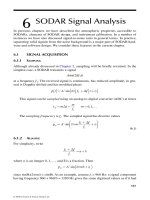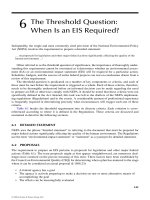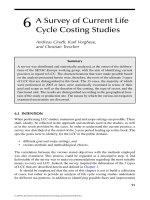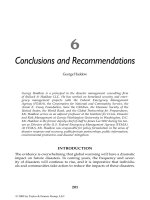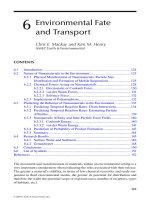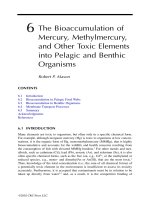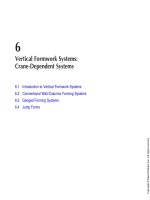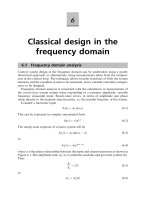Environmental Pollution Control Microbiology - Chapter 6 pdf
Bạn đang xem bản rút gọn của tài liệu. Xem và tải ngay bản đầy đủ của tài liệu tại đây (1.04 MB, 17 trang )
Chapter
6
PROTOZOA
AND
OTHER
ANIMALS
Microscopic animals
differ
from
microscopic plants
by
their ability
to
metabolize
solid particles directly. Actually,
the
protozoa
and
higher animals
hydrolyze
the
solid
organics
internally rather than externally.
The
animals
have complex
metabolic systems that allow them
to
metabolize
the
nutrients
and
release
the
inert
portions
of the
suspended organic solids back into
the
environment. Microscopic
animals
range
from
single cells organisms
to
multicell
animals that approach
the
macroscopic size.
The
microscopic animals
are a
part
of the
organic matter that
forms
a
link
in the
food
chain
for
macroscopic organisms.
The
larger organisms
use
smaller
organisms
as
their source
of
nutrients. Although
the
microscopic animals
do not
metabolize waste materials, they play
an
important role
in the
organic waste
stabilization
process.
For
this
reason
it is
important
for
environmental
microbiologists
to
learn
to
recognize
the
different
groups
of
microscopic animals
and the
role they play
in
maintaining
the
environmental balance
in
both aqueous
systems
and
soil systems.
PROTOZOA
Protozoa
are the
simplest
microscopic
animals, being single cell organisms.
In
nature,
bacteria
form
the
major
food
supply
for
protozoa.
The
bacteria concentrate
various nutrients into their protoplasm, making them
the
perfect
food
for the
protozoa.
A
portion
of the
organic matter
from the
bacteria
is
oxidized
to
yield
energy
for the
synthesis
of new
protoplasm
from the
remaining organic matter.
The
Copyright 2004 by Marcel Dekker, Inc. All Rights Reserved.
energy-synthesis relationships
for
protozoa
are
similar
to the
bacteria energy-
synthesis
relationships,
38%
oxidation
and 62% new
cell
mass.
The
large protozoa
can
also
eat
small
algae.
Most
of the
protozoa
are
aerobic, requiring dissolved
oxygen
as
their electron acceptor. There
are a few
anaerobic protozoa.
The
problem with anaerobic protozoa
is
even more acute than with anaerobic bacteria.
Anaerobic organisms must process considerable quantities
of
organic matter
for
energy since most
of the
energy remains
in the
partially metabolized organic
compounds. Anaerobic protozoa will only
be
found
in
environments having very
high organic concentrations
and
high concentrations
of
bacteria. Until more
research
is
carried
out on
anaerobic metabolism
in
protozoa, environmental
microbiologists
will deal with
protozoa
as if
they
are
strict aerobic microorganisms.
DESCRIPTION
Protozoa
are
identified entirely
from
their physical
characteristics.
Microscopic
examination
of the
protozoa
at 100 X
allows observation
of the
major
characteristics used
to
identify
the
different
organisms. Protozoa
are
much larger
than
bacteria,
ranging in
size
from
about
10
um
to
several hundred microns. Since
the
protozoa
have
a
discernable
nucleus, they
are
classified
as
Eucarya.
There
are
five
families
of
protozoa:
(1)
Sarcodina,
(2)
Mastigophora,
(3)
Sporozoa,
(4)
Ciliata
and (5)
Suctoria.
Figure
6-1
shows sketches
of the five
families
of
protozoa,
illustrating
their
major
physical characteristics.
(a)
Sarcodina
(b)
Mastigophora
(c)
Sporozoa
(d)
Ciliata
(e)
Suctoria
Figure
6-1
SKETCHES
OF THE
FIVE
FAMILIES
OF
PROTOZOA
The
Sarcodina
are the
simplest protozoa. They have
flexible
bodies
and
move
by
pseudopodia
created
by
streaming protoplasm within
the
cell while attached
to a
surface.
The
Sarcodina must live
on
solid surfaces
in
order
to
move under control.
If
they lose contact with
a
solid surface,
the
Sarcodina have
no
control over their
movements
and
simply
drift
with
the fluid
currents.
The
nucleus
and
food
vacuoles
Copyright 2004 by Marcel Dekker, Inc. All Rights Reserved.
are
easily observed
in the
Sarcodina.
They
eat by
engulfing their food.
As the
cell
wall moves over
the
solid
food,
the
food
goes
from
outside
the
cell
to
inside
the
cell where
it can be
solubilized
by
enzymes.
The
soluble nutrients
are
taken inside
the
cell
and
used
for
energy
and
synthesis.
The
Amoeba
is the
most common
Sarcodina
and is
widely distributed
in the
environment.
Unfortunately,
the
Sarcodina
are not
efficient
food
gatherers compared
to the
other protozoa
and are
not
able
to
compete
efficiently
against
the
other protozoa. They will
be
found
growing
on
solid surfaces where
bacteria
and
algae
are
attached. Some
of the
Sarcodina
have
the
ability
to
create solid shells that
can
protect
them
from
small
predators.
A few of the
Sarcodina
are
pathogenic.
The
Entamoeba
histolytica
is
one of the
most
famous
pathogens.
It was
responsible
for an
epidemic
at the
1933
Chicago World's Fair. Entamoeba were carried
by a
cross-connection
in a
large
hotel
in
Chicago
to a
number
of
rooms
from the
sewage
of a
contaminated guest.
The
cross-connection allowed
the
sanitary sewage
to
enter
the
water distribution
system within
the
hotel
by
mistake.
The
newly contaminated guests
of the
hotel
carried
the
protozoa
back home when they
left
Chicago, making
it
very
difficult
to
trace
the
magnitude
of the
epidemic.
One of the
positive aspects
of
this epidemic
was to
focus
attention
on the
elimination
of
cross-connections between sanitary
sewage pipes
and
water distribution pipes.
The
Sarcodina
form
cysts when
the
environment
becomes
unfavorable.
The
cysts
are
quite similar
to
bacterial spores
and
protect
the
nucleus with
a
hard coating. When
the
cysts return
to a
favorable
environment,
the
nucleus stimulates normal protozoa growth. Growth
of
Entamoeba
inside animals results
in the
discharge
of
large numbers
of
cysts
in
feces
from the
infected
animal.
In
countries where untreated sewage
is
applied
directly
to
agricultural
fields as a
fertilizer,
the
cysts
become attached
to the
crops.
If
the
crops
are
eaten without adequate treatment,
the
cysts
are
ingested
and
grow
again,
allowing
the
cycle
to
continue unabated.
The
Endamoeba
are
parasitic
pathogens, drawing
all
their nutrients
from
their hosts.
The
parasites
sap the
strength
of
people
and
reduce their ability
to
work. Endamoeba
are
seldom
fatal,
except
for
people
who
have
a
damaged immune system. Sewage treatment
can
remove
the
parasites
from
human
wastewaters
and
break
the
growth cycle
of
this
parasite. Medical treatment
of the
infected
individual
can
also destroy
the
pathogen. Individual treatment
is a
more
difficult
and
expensive
way to
control
the
spread
of the
pathogen
in
large populations than
wastewater
treatment.
Mastigophora
are the
flagellated protozoa. They have
from one to
four
flagella
that
are
used
for
motility
and for
gathering food.
The
Mastigophora
are
divided into
two
groups,
Phytomastigophora
and
Zoomastigophora.
The
Phytomastigophora
are
flagellated
protozoa that
are the
transition
phase
between bacteria
and
algae.
Like
bacteria,
the
phytoflagellates
metabolize soluble nutrients. Because
of
their
large size
the
phytoflagellates cannot compete against
the
bacteria
and can
survive
only
in
concentrated organic environments before
the
bacteria
begin
to
grow
and
Copyright 2004 by Marcel Dekker, Inc. All Rights Reserved.
predominate.
Protozoologists
consider flagellated algae
as a
major
part
of the
phytoflagellated
protozoa;
but
environmental
microbiologists
have kept
the
photosynthetic
phytoflagellates
with
the
algae
and the
non-photosynthetic
phytoflagellates
with
the
protozoa. Growth
of
bacteria permits
the
zooflagellates
to
grow
since they
eat
bacteria
for
their food.
The
inefficiency
of the
zooflagellates
in
obtaining nutrients keeps their populations
low
except
in
very
high
bacteria
populations.
Mastigophora
are
easily recognized under
the
microscope because
of
their
size
and
their slow undulating motion.
Mastigophora
range
in
size
from
10
um
to
over
100 um. It is
possible
to see the flagella
under
the
optical microscope.
The
Sporozoa
are
parasitic protozoa that have complex
life
cycles.
The
formation
of
spores
is the
chief characteristic
of the
Sporozoa.
Plasmodium
vivax
is the
most
common
Sporozoa.
It is the
causative agent
for
malaria,
one of the
most common
diseases around
the
world. Malaria
is
transmitted
by
mosquitos
from
person
to
person.
The
mosquito plays
an
important part
in the
growth
of
this parasitic
protozoa,
as
well
as in its
movement
in the
environment. Limiting mosquito
populations
has
provided control over this disease since
it
cannot
be
transmitted
without
the
host mosquito.
The
Ciliata
use
short cilia
for
motility
and
gathering
food.
They
are
grouped
as
free-swimming
ciliated protozoa, crawling ciliated protozoa,
and
stalked ciliated
protozoa.
The free-swimming
ciliates
move very quickly
and
require lots
of
food
for
energy. Dispersed bacteria
are the
primary source
of
food
for the free-
swimming
ciliated
protozoa.
They come
in
many sizes
and
shapes, ranging
from 20
um
to 300 um in
length. Paramecium
is the
typical
free-swimming
ciliated
protozoa that most people recognize;
but the
smaller
Tetrahymena
is
more
common, since
it
requires less
food
for
survival.
Blepharisma
is an
easy
free-
swimming
ciliated protozoa
to
recognize because
of its
pink color. Paramecium
bursaria
is
also
interesting with
the
algae,
Chlorella,
growing inside
the
protozoa.
The
protozoa
and
algae
find the
relationship suitable
for
both organisms.
Stylonychia
and
Euplotes
are
more complex
free-swimming
ciliates with cirri
on
their underneath side.
The
cirri allow these
free-swimming
ciliates
to
crawl over
solid surfaces
in
search
of
food.
The
crawling ciliates require less energy than
the
free-swimming
ciliates
and
survive better
as
food
becomes limiting.
The
stalked
ciliates
are
ciliated protozoa that have stalks
to
permit them
to
attach
to
surfaces.
The
cilia located near
the
mouth
are
primarily
for
food
gathering,
but can be
used
for
motility.
The
stalked ciliates
can be
found
as
single cells
or as
colonies
of
cells.
Some
of the
stalked ciliates have stalks that contract
and
some have rigid stalks.
Stalked ciliated protozoa
and
crawling ciliated protozoa require
the
least amount
of
food
for
survival
as far as
ciliated protozoa
are
concerned. Under adverse
environmental conditions,
the
stalked ciliated protozoa
form
cilia around
the
bottom
of the
cell near where
the
stalk
is
attached.
The
stalked ciliated protozoa
Copyright 2004 by Marcel Dekker, Inc. All Rights Reserved.
can
detach
itself
from the
stalk
and
becomes
a
large,
free
swimming ciliated
protozoa.
It can
become attached again when environmental conditions
are
suitable. Figure
6-2
shows sketches
of the
three
different
groups
of
ciliated
protozoa.
(a)
Free-Swimming
Ciliate
(b)
Stalked
Ciliate
(c)
Crawling
Ciliate
Figure
6-2
SKETCHES
OF
THREE MAJOR GROUPS
OF
CILATED
PROTOZOA
Suctoria
are
interesting protozoa that look
like
stalked ciliated protozoa. Instead
of
having open mouths
for
feeding,
the
Suctoria
use
hollow
tubes
to
suck their
nutrients
inside
the
cell.
Suctoria
are
parasites, using
free-swimming
ciliates
as
their source
of
food.
The
Suctoria
are
more complex protozoa, having
two
phases
in
their
life
cycle.
The
stalked growth
is one
phase
and a free-swimming
ciliate
is
the
other phase. Since
the free-swimming
ciliated
protozoa used
for
nutrients
are
quite large,
it
takes considerable
time
for the
Suctoria
to
capture
and to eat a free-
swimming ciliate. Suctoria
will
be
observed only when there
are
large numbers
of
free-swimming
ciliated
protozoa
in the
environment.
The
growth
of
protozoa
is
similar
to the
growth
of the
other microorganisms. Nutrients
and
environment
determine
which protozoa grow
and the
extent
of
that growth.
METABOLISM
AND
GROWTH
Protozoa
are
primarily aerobic organisms, requiring dissolved oxygen
as
their
electron acceptor. Although protozoa
can be
grown
in
concentrated, complex
nutrient
media, they prefer
to use
bacteria
as
their source
of
nutrients.
The
bacteria
are
concentrated nuggets
of
nutrients.
The
protozoa metabolize
the
biodegradable
portion
of the
bacteria
for
energy
and
synthesis
and
excrete
the
non-biodegradable
fraction
back into
the
environment.
The
protozoa
must continuously ingest
nutrients
or
they will have
to
consume their
own
cell mass
and
die.
A
number
of
studies have been carried
out
over
the
years evaluating
the
relationships between
the
growth
of
bacteria
and
protozoa.
Copyright 2004 by Marcel Dekker, Inc. All Rights Reserved.
Butterfield,
Purdy,
and
Theriault
carried
out one of the
earliest studies
on
bacteria-
protozoa metabolism
in
1931.
They were
able
to
obtain
a
pure culture
of
Colpidium,
a
small,
free
swimming ciliated protozoa, varying
in
size
from 50 to 70
um
in
length. They used
a
dilute
glucose-peptone
solution
as a
growth media
and
quickly
found
that
Colpidium
could
not
survive
in a 5
mg/L
solution
of
each
nutrient,
a
total
of
10
mg/L
nutrients, unless
the
media became contaminated with
bacteria.
Increasing
the
glucose-peptone concentration
to
5,000
mg/L
of
each
nutrient,
10
g/L
total nutrients, provided
sufficient
nutrients
for the
Colpidium
to
grow quite well without bacteria
in a
batch-fed
bioreactor.
It
took
the
Colpidium
23
days
to
reach
its
maximum
population,
15,600/ml,
when grown
at
20°C
in the
concentrated nutrients.
The
Colpidium
used
245
mg/L
oxygen,
about 0.016
ug/cell.
Once
the
Colpidium
reached their maximum population, they began
to
slowly
die
while using dissolved oxygen
to
remain alive
by
endogenous respiration. They used
55
mg/1
DO
over
the
next
4
days,
3.9
x
10"
5
ug/hr/cell.
It
appeared that oxygen
transfer
limited metabolism
in
both
the
growth
and the
endogenous phases. Using
a
dilute glucose-peptone solution containing
5
mg/1
of
each nutrient
and
Aerobacter
aerogenes
as the
bacteria
together
with
Colpidium,
they
found
that
the
bacteria
metabolized
the
organics
to new
cells with
the
utilization
of
oxygen
in the
batch-fed
bioreactor.
The
Colpidium
growth lagged
the
bacteria
growth,
but
quickly began
to
reduce
the
bacteria population.
The
protozoa reached
its
maximum population
in 5
days incubation
at
20°C. Both
the
protozoa
and
bacteria populations slowly
decreased
after
5
days.
The
numbers
of
Colpidium
reached
180/ml
in 5
days
and
dropped
to
10/ml
by Day 10. The
bacteria population reached
6.9 x
10
6
/ml
after
one
day and was
down
to 0.7 x
10
6
/ml
by Day 10.
Their study gave some
additional data.
The
growth
of
Aerobacter aerogenes
in the
dilute glucose-peptone
solution used
3.0
mg/1
DO in 5
days incubation
at
20°C. Adding
the
protozoa,
Colpidium,
to the A.
aerogenes gave
an
oxygen uptake
of 4.8
mg/L
in 5
days.
Using
a
mixture
of
several
different
bacteria
in the
same substrate gave
4.3
mg/L
oxygen uptake. With
Colpidium
the
mixture
of
bacteria used
5.2
mg/L
DO.
Finally,
river
water with mixed
bacteria
and
mixed protozoa used
6.4
mg/L
DO
under
the
same conditions. These data showed that
the
protozoa
were dependent
upon
the
bacteria
to
concentrate nutrients
in
dilute organic environments
and
that mixtures
of
microorganisms were more
efficient
at
metabolism
than
pure cultures. This
is not
surprising since
the
most
efficient
microorganisms grow
and
provide
the
greatest
stabilization
in the
shortest time.
In
1972
Tsuchiya,
Drake,
Jost,
and
Fredrickson
published
the
results
of
their study
on
the
interaction
of the
amoeboid
protozoa,
Dictyostelium
discoideum,
and
Escherichia
coll.
In a
continuously
fed
bioreactor with
500
mg/1
glucose
as the
substrate,
E.
coli
metabolized
the
glucose
and
produced about
1.5 x
10
9
bacteria/ml.
The
amoeboid protozoa began
to eat the E.
coli
and
increased
in
numbers.
The
protozoa
metabolism produced
a
major
drop
in the E.
coli
population
Copyright 2004 by Marcel Dekker, Inc. All Rights Reserved.
and
a rise in
glucose concentration
after
several days
of
operation.
As the
E.
coli
population
decreased,
the
protozoa population also began
to
decrease.
The
increased
glucose concentration stimulated
the E.
coli
to
grow.
The
glucose
concentration soon dropped quite
low and
became growth limiting
for the E.
coli.
The
protozoa
found
a
ready supply
of
food
again
and
began
to
grow
at the
expense
of
the E.
coli.
The
oscillations
in
bacteria
and
protozoa populations eventually
became damped
and the
system operated with
a
balance between substrate
fed and
the
growth
of
both microorganisms.
At
25°C
the
(VK
for
D.
discoideum
was
0.24/hr
and
0.25/hr
for E.
coli. With continuous feeding
of
nutrients,
one
would
expect that
the
\i
for
both organisms growing together would
be the
same.
The
half-
saturation constant,
Kj,
was 4
x
10
8
bacteria/ml
for the
protozoa
and 0.5
mg/1
glucose
for the
bacteria. Quantitative evaluation
of the
data indicated that
it
took
1.4
x
10
3
bacteria
to
create
an
amoeba
and 3.3 x
10"
10
mg
glucose
to
produce
a
bacterium.
This same group continued their study
of
competition between protozoa
and
bacteria
by
examining
two
bacteria,
E.
coli
and
Azotobacter
vinelandii.
Azotobacter
vinelandii
are
nitrogen-fixing bacteria that
can use
glucose
as its
substrate,
the
same
as E.
coli.
The two
bacteria
are
quite
different
in
size.
E.
coli
has a
mean cell volume
of 0.3
um
j
;
while
the
Azotobacter
has a
mean cell volume
of
3.0
um
j
.
Azotobacter
has to
metabolize much more glucose
to
produce
a
single
cell
than
E.
coli. Size differential
is a
major
factor
affecting
competition between
microorganisms.
The
microorganisms with
the
greatest
surface
area
to
mass ratio
have
a
distinct advantage over
the
other microorganisms. Growth
of the two
bacteria
in a
simple, continuous
feed
system without
the
protozoa resulted
in the E.
coli
displacing
the
Azotobacter
in a
short period
of
time. Theoretically,
the E.
coli
should
not
completely displace
the
Azotobacter since both
can
compete
for the
soluble
substrate.
The
smaller, faster growing
E.
coli should have been
and was the
predominant
bacteria.
In
this study,
a
free-swimming
ciliated protozoa,
Tetrahymena
pyriformis,
was
used, since they were
far
more
efficient
at
gathering
food
than
the
amoeboid protozoa used
in the
previous study.
In the
presence
of the
ciliated
protozoa, both bacteria groups survived.
E.
coli could
not
displace
Azotobacter
when
the
protozoa
ate the
bacteria. Together,
the E.
coli
had a
population around
1 x
10
9
cells/ml with Azotobacter around
3 x
10
7
cells/ml
and
the
Tetrahymena
around
6 x
10
J
cells/ml.
The
faster growing
E.
coli appeared
to
provide most
of the
nutrients
for the
protozoa,
depending upon
the
accuracy
of the
bacteria numbers
and
their corresponding volumes. Predator-prey relationships
and
competition between microorganisms
for
nutrients
are
very important
in
allowing
the
various groups
of
organisms
to
survive
in the
real world.
An
interesting reaction
was
observed when they attempted
to
grow
the
microorganisms
at
fluid
retention
periods greater than
15
hours. They noted that
the
bacteria aggregated, making
it
impossible
to
distinguish between
the two
organisms. Aggregation
of
bacteria
is
Copyright 2004 by Marcel Dekker, Inc. All Rights Reserved.
very
important
in
environmental microbiology
and has an
important impact
on
bacteria survival. This study clearly demonstrated that
flocculation
occurred when
food
became limiting
in the
environment,
hi
an
excess
of
nutrients
the two
bacteria
species remained dispersed with
the
protozoa.
Growth
of
Tetrahymena
pyriformis
on
pure cultures
of
bacteria
was the
subject
of a
study
by
Holm
and
Smith. They used
the
bacteria,
Citrobacter,
which
contained
8.6
x
10"
11
mg
carbon/cell.
The
Tetrahymena
contained
1.1
x
10"
6
mg
carbon/cell.
The
free-swimming
ciliated protozoa required
3 x
10
4
bacteria
to
produce
a
single
new
cell.
The
overall metabolic
efficiency
was
about 42%.
The
same year,
Sudo
and
Aiba
reported
on the
isolation
and
growth
of the
stalked ciliated
protozoa,
Vorticella
microstoma.
They used
Alcaligenes
faecalis
as the
source
of
food
for the
Vorticella.
They
found
that
the
weight
of
Vorticella
averaged 3.85
x
10"*
mg/cell
and
had a
u^
of 2.2
days.
The
cell yield
of
protozoa
was
about 47%, based
on
mass
of
bacteria
metabolized.
The
metabolic data
from
these
studies demonstrated that
the
aerobic growth
of the
protozoa
followed
the
same general relationships
of
metabolism
as the
other
microorganisms.
The
difference
was the
bacteria
supplied both
the
energy
and the
components
for
cell synthesis.
The
energy content
of
bacteria
is
less
than
100%
based
on
VSS.
The net
result
is
less synthesis
of
protozoa than would
be
expected.
As
large organisms,
the
protozoa must metabolize large numbers
of
bacteria
to
make
a new
cell.
Fenchel
reported protozoa used
50% to 60% of
their nutrients
for
cell
synthesis.
The
endogenous respiration rate proceeded
at 2% to 5% of the
normal growth rate
in
protozoa.
The
dispersed
bacteria
in the
environment
form
the
best source
of
nutrients
for the
protozoa;
but
bacteria
on the
surface
of
soil
particles
or on the
surface
of
bacteria
floe
also
can be
used
for
nutrients.
Although
the
majority
of
protozoa
are
aerobic organisms, there
are
anaerobic
protozoa.
Like their bacteria counterparts,
the
anaerobic protozoa must
eat
tremendous quantities
of
nutrients
in
order
to
obtain
sufficient
energy
for
cell
synthesis.
The low
bacteria
growth
in
anaerobic environments means anaerobic
protozoa will only
be
found
in
high organic concentration environments. Fenchel
and
Finlay
reported that anaerobic protozoa
had an
overall yield
of
about
10% of
their nutrients. They indicated that there were anaerobic protozoa with methane
bacteria
growing inside
the
protozoa.
As the
protozoa produced organic acids,
the
methane
bacteria converted
the
organic acids
to new
cells
and
methane gas.
The
methane
metabolism removed potentially toxic
organics
from the
protozoa
and
supplied
the
protozoa
with
additional nutrients. There
are
both
flagellated and free-
swimming
ciliated,
anaerobic
protozoa
with
the
predominant numbers being
ciliated
protozoa.
The free-swimming
ciliated protozoa predominate over
the
flagellated
protozoa
in
anaerobic environments
for the
same reason that they
Copyright 2004 by Marcel Dekker, Inc. All Rights Reserved.
predominate
in
aerobic environments.
The free-swimming
ciliated protozoa
are
simply
more
efficient
in
capturing bacteria
for
food
than
the
flagellated
protozoa.
Because
of the
limited environments
for
anaerobic protozoa, protozoa were
considered
as
being strictly aerobic
for
many years. More research
is
definitely
needed
on
anaerobic protozoa
to
establish their relationships
in the
environment.
POPULATION
DYNAMICS
In the
natural environment
the
different
groups
of
protozoa compete
for
nutrients.
All of the
major
groups
of
protozoa
will
be
found
living together
in
numbers
proportional
to
their ability
to
obtain nutrients.
The
natural environment
is
more
dynamic
than static
and
does
not
allow
a
static equilibrium
to
exist
for any
extended period
of
time.
The
addition
of
organic nutrients
to the
aquatic
environment stimulates
the
growth
of
bacteria
best
equipped
to
metabolize
the
specific
organic compounds.
The
growth
of the
bacteria will
be
aerobic
as
long
as
there
is
sufficient
dissolved oxygen
in the
water.
If the
bacteria remove
the
dissolved oxygen, metabolism
shifts
from
aerobic
to
anaerobic. Since most
protozoa will
not
grow under anaerobic conditions, there will
be no
significant
growth
of
protozoa until
the
rate
of
bacteria metabolism slows
and the
system
becomes aerobic again. Figure
6-3 is a
schematic diagram
of the
population
dynamics
of
microbial
growth
in a
batch
fed
system
following
the
addition
of
organic
nutrients
to
stimulate
the
bacteria.
Both
the
time scale
and the
numbers
of
s
CO
I
LU
Crawling
Ciliates
4
stalked
Ciliates
TIME
Figure
6-3
SCHEMATIC DIAGRAM
OF
POPULATION
DYNAMICS
OF
MICROBIAL GROWTH
IN A
BATCH
FED
SYSTEM
Copyright 2004 by Marcel Dekker, Inc. All Rights Reserved.
organisms
are
distorted
to
show relative growths
of the
different
groups
of
organisms. Small,
flagellated
protozoa will appear
first
since there
are
many
bacteria
to
eat. Larger
flagellated
protozoa
appear next
as
sufficient
food
is
available growth.
The
amoeboid protozoa appear
on
solid
surfaces
where there
are
attached bacteria
for
them
to use as
food.
The
amoeboid protozoa
do not
approach
the
numbers
of the flagellated
protozoa
as the
amoeboid protozoa
are not as
efficient
food
gatherers
as the flagellated
protozoa.
The
small
ciliated protozoa
appear quickly
as the DO
rises.
The
small,
free-swimming
ciliated protozoa move
quickly
through
the
solution,
harvesting
as
many bacteria
as
possible.
The
numbers
of
free-swimming
ciliated protozoa increase rapidly with larger species appearing
in
smaller numbers.
The
numbers
of
bacteria decrease
as the
ciliated protozoa
grow.
If
there
are
enough small
free-swimming
ciliated
protozoa,
a few
Suctoria
will
appear.
As the
bacteria decrease,
the free-swimming
protozoa give
way to the
crawling
ciliated
protozoa that
find
their
food
on
solid
surfaces.
The
crawling
ciliated
protozoa
are
more
efficient
food
gatherers than
the
amoeboid protozoa
at
finding
the
bacteria
on the
solid surfaces. Stalked ciliated protozoa appear
when
the
bacteria numbers drop lower
and
lower.
The free-swimming
protozoa rapidly
decrease
as
they expend
too
much energy trying
to
find
enough bacteria
to
remain
alive.
The
stalked ciliated
protozoa
require many
bacteria
to
grow;
but
they expend
less energy
in
obtaining those bacteria.
As the
bacteria population drops
to
very
low
levels,
the
stalked
ciliates
die
off.
REPRODUCTION
AND
SURVIVAL
Protozoa undergo reproduction
by fission,
splitting into
two
cells along
the
longitudinal axis. Division starts with
the
nucleus splitting
and
creating
the
basis
for
two
separate
cells.
It
takes several hours
for the two
cells
to
completely split.
Growth continues
as
long
as
environmental conditions
are
favorable. When
environmental conditions begin
to
turn
bad for
continued growth
of the
protozoa,
they
form
cysts. Each cyst
is
produced
by
coating
the
nucleus with
a
hard shell,
allowing
the
nucleus
to
survive
in
adverse environments.
The
rest
of the
cell tissues
become nutrients
for
additional bacteria growth. When
the
cyst
finds a
reasonable
environment
for
growth,
the
nucleus begins
to
expand, creating
a new
protozoa.
Environmental factors such
as
pH
and
temperature have
the
same relative
effect
on
protozoa
as on
bacteria. Protozoa grow best
at pH
levels between
6.5 and
8.5.
Strongly acidic
or
strongly alkaline conditions
are
toxic
to the
protozoa.
As far as
temperature
is
concerned,
protozoa
can be
either
mesophilic
or
thermophilic,
the
same
as
bacteria.
Most
protozoa
are
mesophilic, having
a
maximum temperature
for
growth around
40°
C.
Fenchel
indicated that
a few
protozoa have been
found
in
hot
springs
at 50° C.
There
do not
appear
to be
many thermophilic protozoa. Part
of
Copyright 2004 by Marcel Dekker, Inc. All Rights Reserved.
the
problem
is the
lower solubility
of
oxygen
at
higher temperatures. Protozoa
change their rate
of
metabolism
by a
factor
of two for
each
10°
C
temperature
change,
the
same
as the
other organisms. Protozoa have
difficulty
surviving
at
temperatures below
5° C
because
the
viscosity
of the
water
increases,
making
it
more
difficult
for the
protozoa
to
move
and
obtain food.
ROTIFERS
Rotifers
are
multicellular,
microscopic animals
with
flexible
bodies. They
are
larger than protozoa
and
have complex metabolic systems. Like
the
other
microscopic animals,
the
rotifers prefer
bacteria
as
their source
of
food,
but can eat
small algae
and
protozoa.
The
rotifers have cilia around their mouths
to
assist
in
gathering food.
The
cilia also provide
motility
for the
rotifers
if
they
do not
remain
attached
to
solid particles
with
their
forked
tails.
The
flexible bodies allow
the
rotifers
to
bend around
and
feed
on
bacteria
and
algae attached
to
solid surfaces.
A
typical rotifer
is
shown
in
Figure 6-4.
Philodina
is one of the
most common
rotifers.
It is
about
400
urn
long, making
it
easy
to see
under
the
microscope
at
100X
magnification.
The
cilia give
the
appearance
of two
rotating wheels
at the
head
of the
rotifer.
Epiphanes
is a
large rotifer, reaching
600 um in
length. Some
rotifers
are as
small
as 100 um.
Rotifers
are all
strict aerobes
and
must have several
mg/L
dissolved oxygen
in
order
to
grow. They
can
survive
for
several hours
in low
DO
environments,
but not for
long periods.
In
the
presence
of
large bacteria
populations
and
adequate
DO the
rotifers
will
quickly
eat
most
of the
bacteria, even
if the
bacteria
are
flocculated.
In a
suitable environment
the
rotifers
can
quickly
metabolize
all the
bacteria
and
then starve
to
death. Excessive growth
of
rotifers
can
be
controlled
by
reducing
the
dissolved oxygen
to
prevent them
from
growing
so
rapidly.
The DO can be
reduced
to
around
1.0
mg/L
to
favor
the
metabolism
of
aerobic bacteria
and
protozoa
and
slow
the
growth
of
rotifers.
As
large, complex
Figure
6-4
SCHEMATIC DIAGRAM
OF A
TYPICAL ROTIFER
organisms, rotifers require lots
of
bacteria
in
their growth. Rotifers
can
remove
the
bacteria attached
to
solid surfaces
and can
ingest small, flocculated masses
of
bacteria.
They
are
more sensitive
to
environmental stresses than either bacteria
or
Copyright 2004 by Marcel Dekker, Inc. All Rights Reserved.
protozoa.
Temperature
affects
rotifers
the
same
as
temperature
affects
the
other
microorganisms. Their metabolism slows
as the
temperature decreases
and
increases
as the
temperature
rises.
There
do not
appear
to be any
thermophilic
rotifers.
Reproduction
in
rotifers occurs through
egg
formation rather than
by
binary
fission.
Rotifer eggs
can
remain dormant
for a
considerable period
of
time
if
environmental
conditions
are not
satisfactory
for
growth.
It has
been
difficult
to
study
the
quantitative growth characteristics
of the
rotifers
since they cannot
be
grown
free of
bacteria.
Recently,
Walz
reported
on
some studies using
the
rotifer,
Brachionus
angularis,
when
grown
on
algae.
By
using algae
as the
food
for the
rotifers,
it was
possible
to
minimize extraneous organic compounds that would
affect
the
growth
of the
rotifers.
The
algae were grown entirely
on
inorganic components
in the
media,
using light
as the
source
of
energy
for the
algae.
One and two
stage
chemostats
were used
to
evaluate
the
rotifer
growth.
It was
found
that
the
rotifers grew very
nicely
as
long
as the
liquid displacement time
was
under
0.31/d.
When
the
rate
of
dilution
reached
0.34/d,
the
rotifers were washed
out of the
system
and the
algae
population increased.
The
rotifers
had to
consume
20% of
their body weight each
day,
just
to
remain alive without reproducing. Maximum growth occurred when
the
rotifers
consumed
70% of
their body weight each day. About
43% of the
algae
consumed were converted
to
cell
mass.
The
rest
of the
algae cell mass metabolized
was
oxidized
for
energy
as
well
as
excreted
as
inert waste products. Each rotifer
averaged 0.056
ug
C/cell.
More research could yield
a
better understanding
of the
overall metabolic relationships
of
rotifers.
Rotifers
play
an
important role
in the
overall
food
chain
from
bacteria
and
algae
to
higher
organisms.
They
are
widely
found
in the
aquatic environment where there
is
a
suitable environment
for
growth. Rivers, lakes
and
reserviors
are
good sources
of
rotifers.
The
environments that
favor
rotifers tend
to
favor
other higher animal
forms.
CRUSTACEANS
Crustaceans
are
multicellular
animals with hard shells
to
protect their bodies. They
also
have jointed appendages attached
to
their bodies.
The
appendages assist
in
movement
and
food
gathering.
The
large size
of the
crustaceans,
1.5 to 2 mm,
makes them visible
to the
naked
eye if one
looks very
carefully.
They also appear
quite large
in the
microscope,
requiring
low
power magnification
for
good
observation. Being more complex than
the
rotifers,
they grow slower
and are
more
sensitive
to
environmental changes.
The
crustaceans
feed
on
bacteria,
algae,
protozoa,
and
solid organic materials. Figure
6-5
illustrates
the
Daphnia
and the
Copyright 2004 by Marcel Dekker, Inc. All Rights Reserved.
Cyclops,
two
common crustaceans. They
are
easily
found
in freshwater
lakes
in the
warm
summer months. They require high levels
of DO and a
moderate level
of
nutrients.
It has
been estimated that
Daphnia
require about
80% of
their body
a.
Daphnia
b.
Cyclops
Figure
6-5
PHOTOMICROGRAPHS
OF TWO
COMMON CRUSTACEANS
weight
each
day for
maximum growth. Only about
20% of the
food
consumed ends
up
as
cell mass.
The
larger mass
of the
Daphnia requires
a
considerable number
of
smaller
organisms
to
remain alive
and to
grow. Since
the
Daphnia
are
relatively
large,
they become
food
for
macroscopic organisms
in the
water environment.
The
Daphnia
shown
in
Figure
6-5 is
carrying
at
least nine eggs.
As the
microorganisms
become larger, they have
a
harder time obtaining
sufficient
food
to
sustain large
populations.
The
crustaceans tend
to
appear during
the
warm spring
and
fall
weather, when
the
algae populations bloom.
The
crustaceans
can
completely
remove
all the
algae
in a
given
sector
of a
lake
and
then starve
for a
lack
of
food.
Sustained populations
of
crustaceans require
the
continued addition
of a
suitable
food
source.
The
presence
or
absence
of
sufficient
concentrations
of
trace metals
in
the
bacteria
or
algae,
used
as
their
food
source, also
affects
the
magnitude
of
growth
of the
different
species
of
crustaceans.
The
Federal
EPA has
proposed
the
use
of
Ceridaphnia
as the
indicator organism
for
effluent
toxiciry
from
wastewater
treatment plants. Unfortunately,
Ceridaphnia
is a
very sensitive crustacean that
can
be
difficult
to
maintain
in the
laboratory
for
routine use. Researchers
are
currently
examining
other Daphnia
in an
effort
to find a
suitable crustacean that
is
both
sensitive
to
toxic substances
and
easy
to
maintain
in the
laboratory.
Copyright 2004 by Marcel Dekker, Inc. All Rights Reserved.
NEMATODES
AND
OTHER
WORMS
Microscopic worms
are not
common
in the
natural environment. Most
of the
worms
are
macroscopic
and
will
not be
discussed.
The
simple microscopic round
worms
are
nematodes.
Like other higher
animals
the
nematodes
feed
primarily
on
bacteria
and
small organic particles.
A
typical
nematode
is
shown
in
Figure 6-6.
Nematodes range
in
size
from
1,000
to
2,000
um,
making
them easy
to
observe
*
•"
,»«*«!
Figure
6-6
PHOTOMICROGRAPH
OF A
TYPICAL NEMATODE
under
the
microscope
at low
power. Nematodes have complex digestive systems
that
are
readily apparent under
the
microscope.
One of the
characteristics
of
nematodes
is a
constant thrashing motion trying
to
breakup small particles
for use
as
food.
The
nematodes require very large quantities
of
food
to
survive
and
will
only
be
found
where adequate nutrients
and a
reasonable environment exists.
The
female
nematodes
are
responsible
for egg
production
and
reproduction
of the
species.
The
nematode eggs
are
well protected
by a
tough covering
of
chitinous
material. Nematodes require
a
moderate level
of DO to
survive.
Diplogasteroides
is
one of the
common nematodes
found
in
aqueous systems. Nematodes
can
also
be
found
in
soil systems where they tend
to be
plant parasites. Since nematodes tend
to
grow best
near
the
soil
surface,
they
are
easily washed into natural watercourses.
Environmental
microbiologists
become quite familiar with nematodes.
Other microscopic worms
found
in the
aqueous environment include
the
bristle
worm
with large orange
spots,
making them easy
to
identify.
The
bristles projecting
along
the
entire
length
of the
body
of the
worm makes
it
recognizable under
the
microscope. Bristle worms range
in
size
from
3,000
to
7,000
um in
length
and are
Copyright 2004 by Marcel Dekker, Inc. All Rights Reserved.
hard
to
classify
as
microscopic. They cannot
be
viewed
in
their entirety
in a
single
field
except
at
very
low
power magnification. Bristle worms
are not as
common
as
nematodes
as
they have
a
more complex metabolic system, requiring more
nutrients.
There
are
many other worms that tend
to
approach macroscopic
size.
Tubifex
is a
red
worm that
is
found
in
sludge deposits.
It is
definitely macroscopic. There
are
also
many
different
worm-like
larvae that have been observed
in
trickling
filter
slimes
in
wastewater
treatment plants. These worms
and
larvae
are
important
in
environmental
wastewater treatment systems
but are of
limited importance
in
environmental microbiology. Simple recognition
of the
organisms
in
samples
is
usually
all
that
is
needed.
ENVIRONMENTAL CONCERNS
The
microscopic animals play
a
dual role
in
environmental concerns.
The
major
concern lies with
the
pathogenic protozoa.
Entamoeba
histolytica
is no
longer
a
serious
problem
in the
United
States,
but
still remains
a
problem
in
many
developing nations
of the
world lacking
in
modern sanitation. Public health
problems have been created
in the
developed countries
by two
protozoa,
Giardia
lamblia
and
Cryptosporidium
parvum.
Pathogenic protozoa tend
to be
transmitted
through
drinking water
as
spores
or
oocysts.
The
federal
EPA has
developed
regulations
to
control transmission
of all
types
of
pathogenic microorganisms
through public water systems.
Most protozoa play
a
positive role
in
wastewater treatment systems
by
eating
the
dispersed
bacteria
and
producing
a
clarified
effluent.
The
success
of
aerobic
wastewater treatment systems depends
upon
the
balanced population
of
bacteria
and
protozoa.
Protozoa
and
higher animals contribute
to
maintaining high water
quality
in our
streams
and
lakes.
The
types
of
protozoa
found
in
various
environmental systems
are
excellent indicators
of the
current health
of
those
systems.
It is
essential
for
environmental
microbiologists
to
have
an
understanding
of the
important
microscopic
animals
and
their contributions
to the
success
of our
environmental
pollution control projects.
THINGS
TO
REMEMBER
1.
Protozoa
are
single cell microorganisms.
2.
Protozoa
use
bacteria
as
their primary source
of
food.
Copyright 2004 by Marcel Dekker, Inc. All Rights Reserved.
3.
Protozoa metabolism
is
similar
to
bacteria metabolism.
4.
Most protozoa
are
aerobic.
5.
Anaerobic protozoa
can
only
grow
at
high
organic
food
levels.
6.
Protozoa
form
cysts
for
survival under adverse environments.
7.
Rotifers
are
multicellular
microscopic animals.
8.
Rotifers
are
strict
aerobes,
requiring dissolved oxygen
for
metabolism.
9.
Rotifers
reproduce
by
eggs rather than
by
simple binary fission.
10.
Crustaceans
are
large, multicellular, microscopic animals with hard shells.
11.
Crustaceans
can eat
bacteria,
algae,
and
protozoa.
12.
Nematodes
are
common microscopic
roundworms.
13.
Nematodes
eat
large numbers
of
bacteria
for
growth.
14.
A few
protozoa
are
pathogenic;
but
most protozoa help keep
the
environment clean.
REFERENCES
Anderson,
O.
R.
(1987)
Comparative
Protozoology,
Springer-Verlage,
Berlin.
Butterfield,
C.
T.,
Purdy,
W.
C.
and
Theriault,
E.
J.
(1931)
Experimental Studies
of
Natural
Purification
in
Polluted Waters
IV. The
Influence
of the
Plankton
on
the
Biochemical Oxidation
of
Organic Matter, Public Health Reports,
46,
393.
Drake,
J. F. and
Tsuchiya,
H.
M.
(1977)
Growth Kinetics
of
Colpoda
steinii
on
Escherichia
coli,
Appl.
Environ.
Microbiol.,
34, 18.
Fenchel,
T.
(1987)
Ecology
of
Protozoa,
Science Tech, Madison,
WI.
Holm,
H. W. and
Smith,
F. A.
(1970)
Effects
of
Protozoa
on the
Fate
of
Paniculate
Carbon,
EPA-660/3-73-007.
Copyright 2004 by Marcel Dekker, Inc. All Rights Reserved.
Jost,
J.
L.,
Drake,
J.
F.,
Fredrickson,
A. G. and
Tsuchiya,
H. M.
(1973)
Interactions
of
Tetrahymena
pyriformis,
Escherichia
coli,
Azotobacter
vinelandii
and
Glucose
in a
Minimal
Medium",
J.
Bacterial.,
113,
834.
Lee,
J.
J.,
Hutner,
S.
H. and
Bovee,
E.
C.
(1985)
An
Illustrated Guide
to the
Protozoa, Society
of
Protozoologists,
Lawrence,
KS.
Sleigh,
M. A.
(1989)
Protozoa
and
Other
Protists,
2
nd
Ed.,
Edward Arnold,
London, England.
Stone,
A.
R.,
Platt,
H. M. and
Khalil,
L. F.
(1983)
Concepts
in
Nematode
Systematics,
Academic Press,
New
York.
Sudo,
R. and
Aiba,
S.
(1973) Mass
and
Monoxenic
Culture
of
Vorticella
microstoma
Isolated From Activated
Sludge,
Water
Research,
7,
615.
Tsuchiya,
H.
M.,
Drake,
J.
F.,
Jost,
J. L. and
Fredrickson,
A. G.
(1972) Predator-
Prey Interactions
of
Dictyostelium
discoideum
and
Escherichia coli
in
Continuous Culture,
J.
Bacterial,
110,1147.
Walz,
N.
(Editor)
(1993)
Plankton Regulation Dynamics,
Springer-Verlag,
Berlin.
Copyright 2004 by Marcel Dekker, Inc. All Rights Reserved.

